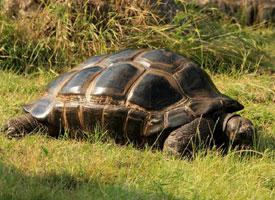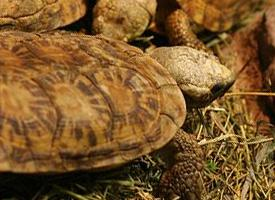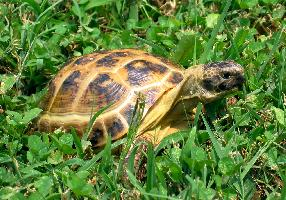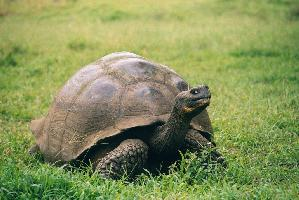
Stav ohrožení
| Ohrožen |
Popis zvířete
The Aldabra giant tortoise (Aldabrachelys gigantea), one of the largest tortoise species in the world, is a remarkable and fascinating creature that has captivated the interest of scientists, conservationists, and wildlife enthusiasts alike. This magnificent reptile is primarily found on the Aldabra Atoll in the Seychelles, a remote group of islands in the Indian Ocean, which has provided a sanctuary that has allowed these tortoises to thrive largely undisturbed by human activity.Characterized by its impressive size, the Aldabra giant tortoise can reach lengths of up to 1.3 meters (about 4 feet) and weigh as much as 250 kilograms (550 pounds), making it one of the heaviest tortoises on the planet. Its domed, bony shell is a striking feature, providing protection from predators and the elements. The shell exhibits varying shades of brown and tan, blending seamlessly with the tortoise's natural environment.
The head and legs of the Aldabra giant tortoise are proportionately large, enabling it to reach vegetation at higher levels. Its strong, sturdy legs are well-adapted for supporting its massive body, while its long neck is an evolutionary adaptation that allows it to graze on leaves and branches that would otherwise be out of reach. This herbivorous reptile has a diet that primarily consists of grasses, leaves, and woody plant stems, playing a crucial role in the ecosystem by acting as a natural lawnmower and seed disperser.
Aldabra giant tortoises are known for their longevity, with many individuals reaching and even surpassing 100 years of age, making them among the longest-lived animals on Earth. This remarkable lifespan is attributed to their slow metabolism and a relatively stress-free life in their natural habitat. However, precise aging is challenging, and age is often estimated based on size and other physical characteristics.
Socially, these tortoises are generally solitary but can be found in groups when grazing or basking in the sun. They are known to have a very slow pace of life, which matches their slow metabolism and contributes to their longevity. Despite their size, they maintain a gentle demeanor and have shown signs of recognizing humans who frequently interact with them, indicating a level of social intelligence.
Breeding occurs at a slow rate, with females laying small clutches of eggs in a sun-warmed nest. The eggs incubate for several months before the hatchlings emerge, tiny and vulnerable, beginning their long journey to adulthood. The survival of these young tortoises is threatened by natural predators and environmental challenges, although adult tortoises have very few natural predators due to their size and protective shells.
Conservation efforts are crucial for the continued survival of the Aldabra giant tortoise, as their populations have faced threats from human exploitation and habitat destruction in the past. Today, they are protected within the Aldabra Atoll, a UNESCO World Heritage Site, which has helped their numbers to remain stable. Conservationists continue to monitor these populations closely, ensuring that this ancient and majestic species can thrive for generations to come.
In summary, the Aldabra giant tortoise is a remarkable species that embodies the beauty and resilience of nature. Its immense size, longevity, and gentle nature make it a fascinating subject of study and an iconic symbol of conservation success. Through continued protection and respect for their natural habitat, we can ensure that the Aldabra giant tortoise remains a part of our world's natural heritage.
Podobná zvířata
Nové fotografie zvířat
Top 10 zvířat
- Chinese water dragon (Physignathus cocincinus)
- Galápagos tortoise (Geochelone nigra complex)
- Dolphin gull (Leucophaeus scoresbii)
- Japanese macaque (Macaca fuscata)
- Colombian red howler (Alouatta seniculus)
- Sea urchins (Echinoidea)
- Moustached guenon (Cercopithecus cephus)
- Diana monkey (Cercopithecus diana)
- Common reed warbler (Acrocephalus scirpaceus)
- Common house mosquito (Culex pipiens)


